Imagine stepping into a culinary realm where elegance meets efficiency—a world where the humble pan transcends its basic function to become a work of art.
In this enchanted realm, the dark-coated pan takes center stage, captivating chefs and home cooks alike with its mysterious allure and unparalleled culinary prowess.
With its sleek obsidian hue and the promise of evenly cooked masterpieces, the dark-coated pan beckons us to explore its secrets and unlock the gateway to culinary perfection.
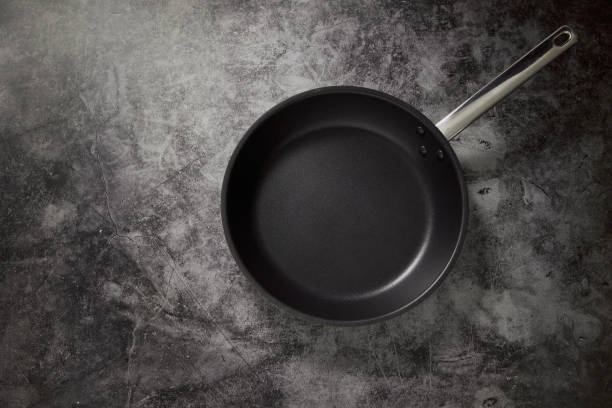
What Is A Dark Coated Pan
A dark-coated pan refers to a cooking utensil with a dark-colored surface, often made of materials like carbon steel or cast iron.
These pans are renowned for their ability to absorb and distribute heat evenly, ensuring thorough cooking. They are commonly described as non-stick, durable, and ideal for searing meats or achieving crispy textures.
Dark-coated pans are favored by many chefs and home cooks for their excellent heat retention properties and versatility in the kitchen.
| Aspect | Dark Coated Pan | Light Coated Pan |
|---|---|---|
| Appearance | Dark-colored surface, often matte or textured | Light-colored surface, usually glossy or shiny |
| Heat Absorption | Absorbs heat well, promotes even cooking and browning | May reflect heat, may require longer cooking times |
| Non-Stick Properties | Often naturally non-stick, may require less oil or butter | May need additional oil or cooking spray for non-stickiness |
| Durability | Generally durable, can withstand high heat and frequent use | May be less durable, prone to scratches and wear |
| Versatility | Suitable for searing, roasting, and achieving crispy textures | Suitable for general cooking, may not be ideal for searing |
| Cleaning | Easy to clean due to non-stick properties and dark surface | Requires careful cleaning to maintain light-colored surface |
| Price | Typically priced higher due to durability and performance | Often more affordable, but may need replacement sooner |
Types Of Dark Coated Pans
There are several types of dark-coated pans available on the market, each designed for specific cooking needs:
Non-Stick Coated Pans

Non-stick coated pans are kitchen essentials renowned for their ability to prevent food from sticking during cooking, reducing the need for excess oil or butter.
These pans feature a special coating, often made of materials like polytetrafluoroethylene (PTFE) or ceramic, that creates a smooth, slick surface.
This non-stick property makes them ideal for cooking delicate foods like eggs and fish without the risk of tearing or sticking. Moreover, cleaning non-stick pans is a breeze, as food residue slides off easily with minimal effort.
However, it’s important to use non-abrasive utensils to preserve the coating’s integrity and avoid scratching, which can reduce its non-stick effectiveness over time.
Overall, non-stick coated pans are versatile, user-friendly, and a valuable addition to any kitchen.
Pros of Non-Stick Coated Pan
- Easy Cleanup: Non-stick coating prevents food from sticking, making cleaning a simple task.
- Healthier Cooking: Requires less oil or butter for cooking, promoting healthier meal preparation.
- Versatile: Suitable for cooking a wide range of foods, from eggs to delicate fish fillets.
- User-Friendly: Ideal for novice cooks or those looking for hassle-free cooking experiences.
- Time-Saving: Faster cooking times as food doesn’t stick to the pan, reducing the need for constant monitoring.
Cons of Non-Stick Coated Pans
- Durability Concerns: Non-stick coatings can wear off over time, especially with frequent use and improper care.
- Not for High Heat: Not suitable for high-temperature cooking or searing, as extreme heat can damage the coating.
- Avoid Abrasive Cleaning: Requires gentle cleaning with non-abrasive tools to prevent scratching and maintain non-stick properties.
- Limited Lifespan: May need replacement after a certain period, depending on usage and maintenance.
- Potential Health Risks: Overheating non-stick pans can release harmful fumes, so it’s crucial to use them within recommended temperature limits.
Anodized Aluminum Pans

Anodized aluminum pans are a popular choice in kitchens for their durability, even heat distribution, and non-reactive properties.
These pans undergo an electrolytic process that creates a hard, dark-colored surface, enhancing their resistance to scratches, corrosion, and staining. The dark coating also promotes efficient heat absorption, ensuring consistent cooking results.
Anodized aluminum pans are versatile and suitable for various cooking techniques, from sautéing to baking. They are often preferred for their ability to withstand high temperatures without warping, making them reliable for both stovetop and oven use.
However, it’s important to note that acidic ingredients or abrasive cleaning methods can affect the anodized coating over time, so gentle care is recommended to maintain their longevity and performance.
Pros of Anodized Aluminum Pans
- Durability: Anodized aluminum pans are highly durable, resistant to scratches, corrosion, and staining.
- Even Heat Distribution: The dark coating promotes uniform heat distribution, preventing hot spots and ensuring consistent cooking.
- Non-Reactive: They are non-reactive, making them suitable for cooking acidic foods without altering taste or color.
- Versatile: Can be used on stovetops, in ovens, and under broilers, offering versatility in cooking methods.
- Easy Maintenance: Requires minimal maintenance, as the non-stick properties of anodized aluminum reduce food sticking and simplify cleaning.
Cons of Anodized Aluminum Pans
- Not Dishwasher Safe: Some anodized aluminum pans may not be dishwasher safe, requiring handwashing to preserve their coating.
- Limited Color Options: Dark-colored coating limits aesthetic choices compared to other pan types.
- Avoid Abrasive Cleaners: Abrasive cleaners and utensils can damage the anodized coating, affecting its non-stick properties.
- Price: Anodized aluminum pans can be more expensive than traditional aluminum or non-stick pans due to their manufacturing process and durability.
- Acidic Foods Caution: While generally non-reactive, prolonged exposure to highly acidic foods may affect the anodized coating over time, necessitating careful use and maintenance.
Ceramic Pans
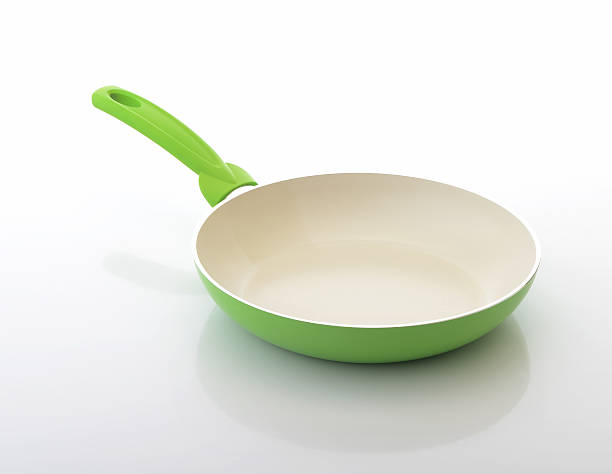
Ceramic pans are gaining popularity among home cooks for their eco-friendly, non-stick cooking surfaces. These pans feature a ceramic coating that is free from harmful chemicals like PFOA and PTFE, making them a safer option for cooking.
The ceramic coating provides excellent non-stick properties, allowing for easy food release and minimal oil or butter use. Moreover, ceramic pans are highly heat-resistant and can withstand high temperatures without emitting toxic fumes.
They are also known for their ability to distribute heat evenly, ensuring thorough and uniform cooking. However, it’s important to note that ceramic pans may require gentle care to avoid scratching the coating, which can impact their non-stick effectiveness over time.
Overall, ceramic pans offer a healthy and convenient cooking experience, suitable for a variety of recipes and cooking styles.
Pros of Ceramic Pans
- Non-Toxic: Ceramic pans are free from harmful chemicals like PFOA and PTFE, making them a safer option for cooking.
- Non-Stick Properties: The ceramic coating provides excellent non-stick properties, reducing the need for excess oil or butter and facilitating easy food release.
- Even Heat Distribution: Ceramic pans distribute heat evenly, ensuring thorough and uniform cooking.
- Heat Resistance: They can withstand high temperatures without emitting toxic fumes, making them suitable for various cooking methods.
- Easy to Clean: Ceramic pans are generally easy to clean due to their non-stick surface, requiring minimal effort for maintenance.
Cons of Ceramic Pans
- Fragile Coating: The ceramic coating can be more prone to chipping or scratching, affecting its non-stick properties over time.
- Not for High Heat: While heat-resistant, ceramic pans may not be suitable for extremely high-temperature cooking or searing.
- Careful Handling: Requires gentle care and non-abrasive cleaning tools to avoid damaging the ceramic coating.
- Limited Lifespan: The non-stick properties of ceramic pans may diminish with regular use and wear, necessitating replacement after a certain period.
- Price: Ceramic pans can be more expensive compared to traditional non-stick pans, reflecting their eco-friendly and durable nature.
Cast Iron Skillets
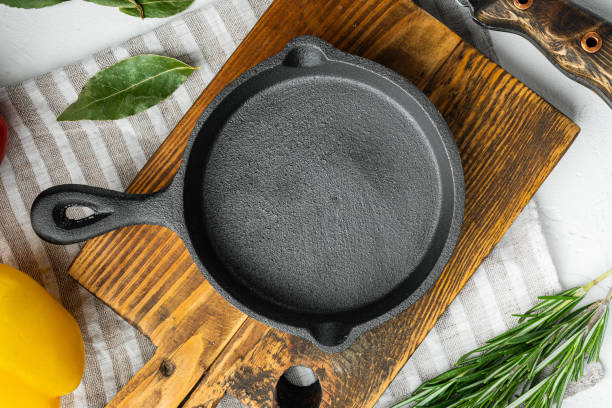
Cast iron skillets are prized for their exceptional heat retention, durability, and versatility in the kitchen. These skillets have a naturally dark and seasoned surface that improves with each use, creating a non-stick cooking surface over time.
They are renowned for their ability to distribute heat evenly, making them ideal for searing, frying, baking, and even grilling. Cast iron skillets can withstand high temperatures, making them suitable for stovetop cooking, oven baking, and even campfire cooking.
Moreover, cooking with cast iron can add trace amounts of iron to your food, providing a nutritional benefit.
However, it’s important to note that cast iron skillets require proper seasoning and maintenance to preserve their non-stick properties and prevent rusting. With proper care, a cast iron skillet can become a cherished kitchen heirloom, lasting for generations.
Pros of Cast Iron Skillets
- Exceptional Heat Retention: Cast iron skillets retain heat well, allowing for even cooking and browning.
- Versatility: Suitable for various cooking methods including searing, frying, baking, and grilling.
- Non-Stick Surface: Develops a natural non-stick surface over time with proper seasoning and use.
- Durable: Cast iron skillets are highly durable and can last for generations with proper care.
- Adds Iron to Food: Cooking in cast iron can add trace amounts of iron to your food, providing a nutritional benefit.
Cons of Cast Iron Skillets
- Requires Seasoning: Cast iron skillets need to be seasoned regularly to maintain their non-stick properties.
- Heavy: Cast iron skillets can be heavy, making them less ideal for some users, especially when handling larger sizes.
- Not Dishwasher Safe: Should not be washed in the dishwasher or soaked in water to prevent rusting.
- Initial Maintenance: New cast iron skillets require initial seasoning before use, which can be time-consuming.
- Prone to Rust: Improper care can lead to rusting, requiring re-seasoning and maintenance.
When To Use Dark Or Light Pans?
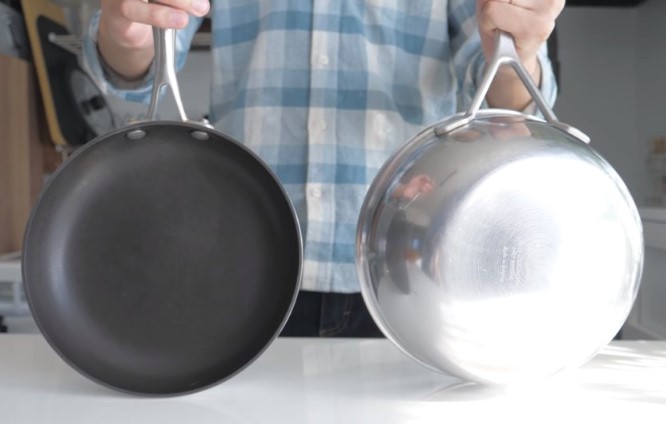
The choice between dark and light pans depends on the type of food you’re cooking and your desired cooking results:
Dark Pans
- For Browning: Dark pans are great for achieving deep browning and crispy textures, making them ideal for searing meats, roasting vegetables, and baking bread.
- Heat Absorption: They absorb heat well and promote even cooking, which is beneficial for dishes that require thorough cooking or caramelization.
- Non-Stick Properties: Dark pans often have non-stick properties, reducing the need for excess oil or butter in cooking.
Light Pans
- For Delicate Foods: Light pans are suitable for cooking delicate foods like eggs, fish, and pancakes, as they may require gentler heat and less browning.
- Temperature Control: Light pans may reflect heat more than dark pans, which can be advantageous when precise temperature control is needed.
- Versatility: Light pans are versatile and can be used for a wide range of dishes, from sautéing vegetables to baking cakes.
4 Tips For Maintaining Your Pans
Certainly, here are four tips for maintaining your pans, regardless of whether they are dark-coated or light-coated:
Use Silicone or Wooden Spoons
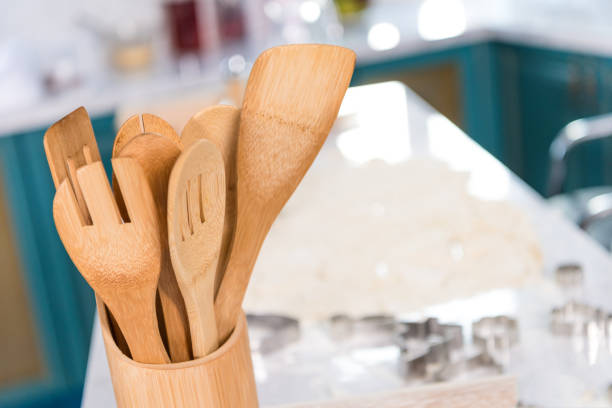
Using silicone or wooden spoons is essential for maintaining the integrity of your pans. These materials are gentle on the pan’s surface, preventing scratches that can diminish non-stick properties over time.
Silicone spoons are heat-resistant and flexible, making them ideal for stirring and scraping without damaging the coating.
Wooden spoons, on the other hand, are sturdy and do not conduct heat, making them suitable for high-temperature cooking without risk of melting or warping.
By choosing silicone or wooden spoons over metal utensils, you can extend the lifespan of your pans and ensure consistent cooking performance.
Cool Before Cleaning
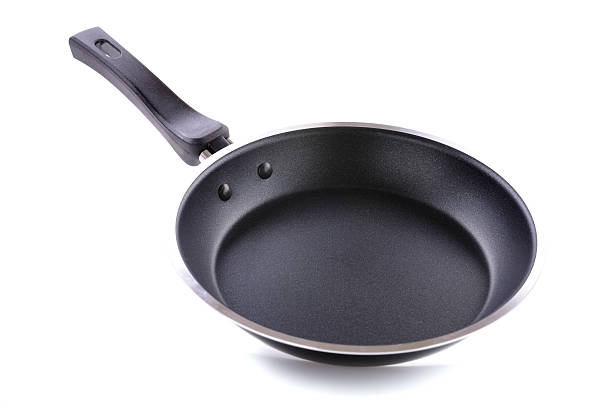
Allowing your pans to cool before cleaning is a crucial step in maintaining their quality and longevity. Rapid temperature changes, such as immersing hot pans in cold water or placing them directly under running water, can cause thermal shock and lead to warping or damage to the pan’s surface.
By allowing your pans to cool naturally to room temperature before cleaning, you reduce the risk of structural changes and preserve their non-stick properties.
Cooling before cleaning allows any stuck-on food to loosen, making it easier to remove without harsh scrubbing or abrasives that can wear down the pan’s coating over time.
Avoid Using The Dishwasher Unless It Claims To Be Dishwasher-Safe
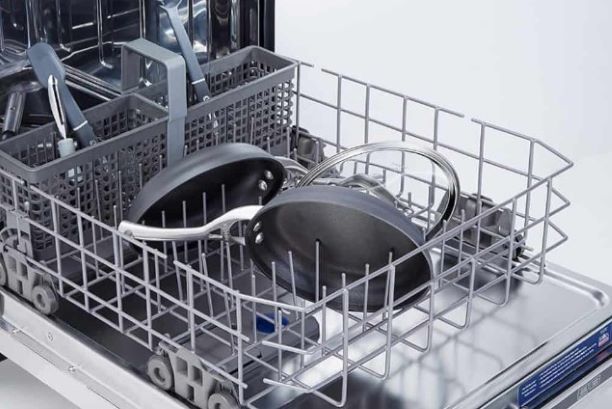
Avoiding the dishwasher unless your pans are labeled as dishwasher-safe is crucial for their maintenance. Dishwashers use harsh detergents, high temperatures, and abrasive cleaning cycles that can damage the non-stick coating or surface finish of your pans.
This can lead to a reduction in their non-stick properties, increased susceptibility to scratches, and a shorter lifespan overall.
Handwashing your pans with a gentle scrub brush and mild dishwashing liquid allows you to control the cleaning process, ensuring that the pans are treated delicately and preserving their quality for longer use.
Use A Gentle Scrub Brush And Dishwashing Liquid
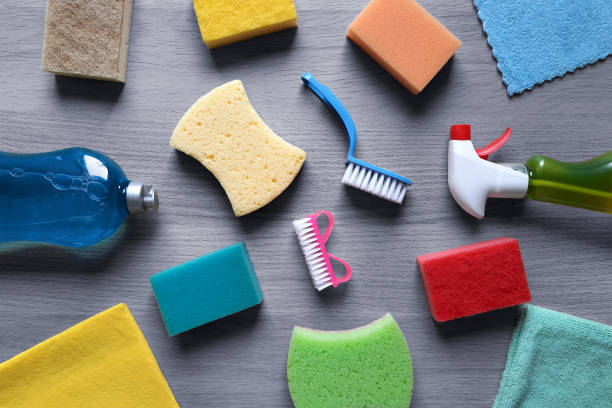
Using a gentle scrub brush and mild dishwashing liquid is key to keeping your pans in top condition. Abrasive cleaners and rough scrubbers can scratch the surface of your pans, diminishing their non-stick properties over time.
A soft scrub brush paired with a gentle dishwashing liquid effectively removes food residue without causing damage. Avoid using steel wool or harsh chemicals, as they can strip away the pan’s coating and reduce its performance.
By opting for gentle cleaning tools and products, you can prolong the lifespan of your pans and maintain their non-stick capabilities for enjoyable cooking experiences.
Restoring Your Blackened Pans
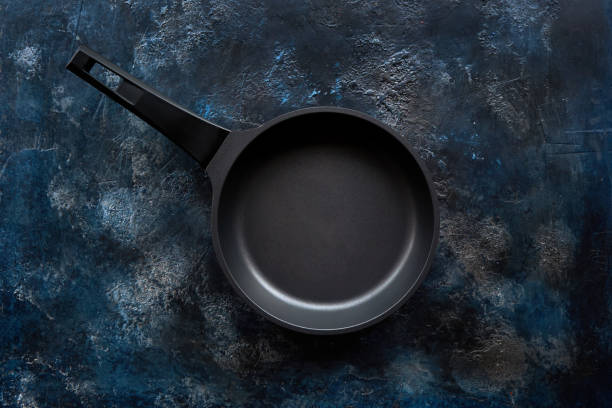
Restoring blackened pans requires a few simple steps to bring them back to their original condition:
Scrubbing with Baking Soda
Start by sprinkling baking soda on the surface of the pan. Then, using a gentle scrub brush or sponge, scrub the baking soda into the blackened areas. Baking soda acts as a mild abrasive that helps lift stubborn stains without damaging the pan’s surface.
Vinegar Soak
For particularly tough stains or burnt-on residue, create a vinegar soak by mixing equal parts white vinegar and water in the pan. Let it soak for a few hours or overnight. The acidity of vinegar helps loosen burnt-on food particles and stains.
Boiling Water
After soaking, bring the vinegar-water mixture to a boil in the pan. This helps further loosen any remaining residue and makes it easier to scrub away.
Scrub and Rinse
Once the pan has cooled down, use the scrub brush or sponge to scrub away the loosened residue. Rinse the pan thoroughly with warm water to remove any remaining traces of vinegar or baking soda.
Seasoning
After cleaning, dry the pan completely with a towel. Then, apply a thin layer of cooking oil or melted shortening to the entire surface of the pan, including the handles.
Place the pan in a preheated oven at a low temperature (around 300°F or 150°C) for about an hour. This process helps re-season the pan, restoring its non-stick properties and protecting it from future staining.
Frequently Asked Questions (FAQs) – Dark Coated Pans
Certainly! Here are some uniquely positive FAQs about dark-coated pans:
Q: What is a dark-coated pan, and why is it special?
A: A dark-coated pan refers to a cooking vessel with a dark-colored surface, typically made of materials like carbon steel, cast iron, or dark non-stick coatings. What makes it special is its ability to evenly distribute heat, resulting in perfectly cooked and beautifully browned foods.
Q: How does a dark-coated pan enhance cooking results?
A: Dark-coated pans excel at absorbing and radiating heat evenly across their surface. This feature ensures that your food cooks uniformly, whether you’re baking delicate pastries or searing meats to perfection. The result? Consistently delicious dishes every time.
Q: Are there any advantages to using a dark-coated pan?
A: Absolutely! One of the key advantages is that dark-coated pans reduce the risk of hot spots, preventing uneven cooking or burning. Moreover, they promote crispier crusts on baked goods and create mouthwatering caramelization on meats and vegetables.
Q: Can dark-coated pans save energy?
A: Yes, they can! Due to their excellent heat retention properties, dark-coated pans require less energy to maintain the desired cooking temperature. This not only saves energy but also shortens cooking times, making meal preparation more efficient.
Q: Are dark-coated pans easy to clean and maintain?
A: Indeed, they are! Many dark-coated pans feature non-stick surfaces that make cleanup a breeze. With proper care, such as gentle hand washing and avoiding abrasive cleaning tools, these pans can maintain their performance and appearance for years to come.
Q: Do dark-coated pans offer versatility in cooking?
A: Absolutely! Whether you’re sautéing, roasting, baking, or frying, a dark-coated pan can handle a wide range of culinary tasks. From achieving golden-brown sears on steaks to creating picture-perfect golden crusts on bread, these pans are a kitchen essential for any home chef.
Q: Can dark-coated pans contribute to healthier cooking?
A: Yes, they can play a role! By promoting even cooking and reducing the need for excessive fats or oils to prevent sticking, dark-coated pans can support healthier cooking practices. This means you can enjoy flavorful meals with less added fats, making it easier to maintain a balanced diet.
Q: Are there any tips for maximizing the performance of dark-coated pans?
A: Absolutely! Preheating the pan before adding ingredients, using moderate heat settings, and avoiding harsh utensils can help preserve the non-stick coating and ensure optimal cooking results. Moreover, following the manufacturer’s care instructions can extend the lifespan of your dark-coated pan.
Q: Do dark-coated pans contribute to a more enjoyable cooking experience?
A: Absolutely! Their ability to provide consistent cooking results, reduce the risk of food sticking, and enhance browning and caramelization makes cooking with dark-coated pans a pleasure. Plus, the aesthetic appeal of beautifully cooked dishes adds to the overall culinary experience.
Q: Can dark-coated pans be used in different types of ovens?
A: Yes, they are versatile enough to be used in various types of ovens, including conventional ovens, convection ovens, and even toaster ovens. Just ensure that the pan is compatible with the specific oven type and follow any manufacturer guidelines for safe use.
Conclusion
A dark-coated pan refers to cookware with a dark, non-stick coating applied to its surface. This coating is typically made of materials like PTFE (Teflon) or ceramic and is designed to provide excellent non-stick properties, making it easier to cook delicate foods without sticking.
Dark-coated pans are popular among home cooks and professional chefs alike for their ability to promote even browning and release food effortlessly. However, it’s essential to use and care for them properly to maintain their performance and longevity.
Overall, a dark-coated pan can be a valuable addition to your kitchen arsenal, enhancing your cooking experience and helping you achieve delicious results with ease.
Other Articles You May Also Like:
- What Is A Popover Pan (6 Cool Facts To Know)
- What Is A Paella Pan (7 Surprising Facts To Know)
- What Is A Dutch Oven (8 Cool Facts To Know)
- What Is A Springform Pan (8 Cool Facts To Know)
- What Is A Popover Pan (6 Cool Facts To Know)
- What Is A Loaf Pan (8 Cool Facts To Know)
- What Is A Cast Iron Skillet? (8 Eye-Opening Things To know)
- What Is A Muffin pan (9 Eye-Opening Things To know)